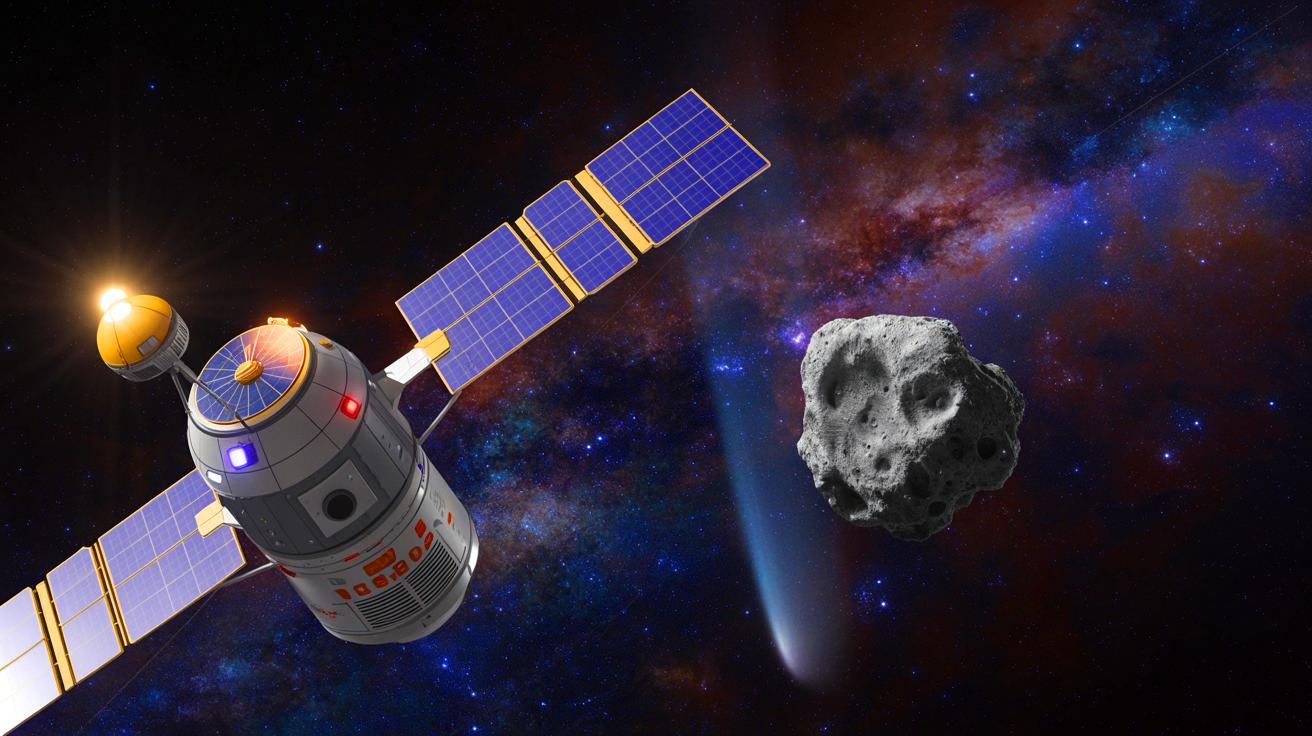- 🚀 Tianwen-2 embarks on a dual-phase mission to collect samples from the asteroid Kamoʻoalewa and study comet 311P/PANSTARRS.
- 🔍 The mission uses innovative techniques like hover sampling, touch-and-go, and anchored drilling to gather valuable data.
- 🔬 Equipped with 11 scientific payloads, Tianwen-2 aims to explore the composition and geological features of celestial bodies.
- 🌌 This ambitious project reflects China’s expanding space ambitions and positions it as a leader in global space exploration.
China has embarked on an extraordinary journey into the far reaches of our solar system, launching the Tianwen-2 mission to gather invaluable data from celestial bodies. This highly ambitious mission seeks to collect samples from the asteroid Kamoʻoalewa, a mysterious body thought to be a fragment of the Moon, and later study the intriguing comet 311P/PANSTARRS. As the probe travels through space, it promises to deliver groundbreaking insights that could reshape our understanding of space and planetary science. With its successful launch, China has set its sights on cementing its position as a major player in the realm of space exploration.
Dual-phase Mission with Ambitious Targets
The Tianwen-2 mission is a testament to China’s growing prowess in space exploration. Launched aboard a Long March 3B rocket from the Xichang Satellite Launch Center, the probe is on a dual-phase mission with distinct goals. The first phase involves reaching the near-Earth asteroid Kamoʻoalewa, which was discovered in 2016 and is believed to be a piece of the Moon. This asteroid, measuring between 131 and 328 feet in diameter, offers a unique opportunity for scientists to understand its structure, mineral composition, and origin.
To successfully collect samples, Tianwen-2 will employ three innovative sampling techniques: hover sampling, touch-and-go, and anchored drilling, depending on the asteroid’s surface conditions. Following the sample collection, the probe will use Earth’s gravity to slingshot itself toward comet 311P/PANSTARRS, expected to occur by 2035. This comet is of particular interest due to its asteroid-like behavior, making it an ideal candidate for studying transitional objects in the solar system.
Complex Navigation, Delicate Maneuvers
Reaching and interacting with small celestial bodies like asteroids and comets presents significant challenges, primarily due to their weak and irregular gravity fields. Unlike planets, these bodies cannot support traditional orbiting methods, necessitating precise and complex navigation. Franco Perez-Lissi, a systems engineer at the European Space Agency, described the task as akin to docking a boat with a mountain floating in space. The Tianwen-2 mission requires the probe to closely match the asteroid’s rotation and speed to achieve successful sampling.
Such maneuvers demand cutting-edge technology and precise execution. The probe must adapt to the unpredictable movements and minimal gravitational pull of these celestial bodies. Successfully accomplishing these tasks will not only allow for sample collection but also pave the way for future missions targeting similar space objects.
Scientific Payoff and Planetary Defense
The scientific rewards from the Tianwen-2 mission could be substantial. Equipped with 11 scientific payloads, including spectrometers, high-resolution cameras, and particle detectors, the probe is designed to study the composition, geological features, and solar wind interactions on both the asteroid and the comet. Past missions, like NASA’s OSIRIS-REx and JAXA’s Hayabusa2, have brought back organic materials such as amino acids and nucleobases, which are essential building blocks of life.
Beyond scientific exploration, the mission also holds potential implications for planetary defense. Understanding the composition and trajectory of near-Earth objects can inform strategies to mitigate potential asteroid impacts. By studying these celestial bodies, researchers can develop better models for predicting and responding to threats from space, enhancing the safety of our planet.
Expanding China’s Space Ambitions
With Tianwen-2, China continues to expand its ambitious space program. This mission follows the successful Tianwen-1 Mars mission and aligns with future plans for Mars sample returns and Jupiter system explorations. As part of a long-term roadmap, China is also eyeing the construction of the International Lunar Research Station and a potential Venus sample return mission.
The commitment to these expansive projects reflects China’s determination to advance its “space dream,” as articulated by President Xi Jinping. The nation is investing heavily in its space infrastructure, including the operational Tiangong space station and plans for a crewed Moon mission later this decade. Such initiatives not only enhance China’s scientific capabilities but also position it as a formidable force in the global space race.
The success of the Tianwen-2 mission could mark a significant leap forward in China’s exploration of the cosmos, offering new opportunities for international collaboration and scientific discovery. As humanity continues to reach for the stars, what new mysteries will these pioneering missions uncover about the universe and our place within it?
Our author used artificial intelligence to enhance this article.
Did you like it? 4.7/5 (26)
